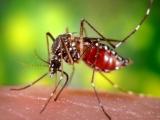In the latest Zika research developments, French researchers reported on new findings on AXL proteins, thought to be Zika virus's entry into developing brain cells, and on an experimental cancer drug that might be useful for blocking infection.
Meanwhile, two other teams reported, in a pair of case studies, more details about the clinical features of the disease in adults, one a pregnant woman infected in Florida who had a widespread rash and the other a German man who had a vasectomy and had evidence of persistent Zika in his semen.
New clues about AXL role
French researchers published the latest findings on the role of AXL, based on in vitro experiments, yesterday in an early online edition of Cell Reports. Testing involved 20- to 26-week-old human fetal cells obtained after legal abortions or miscarriages and human primary astrocytes. The strain of Zika virus they used was isolated from a human case-patient in French Polynesia in 2013.
Earlier studies have suggested that other flaviviruses seem to use the ACL surface receptor to enter cells and cause infection, and work by other scientists has suggested that AXL is one of the human host proteins needed for Zika replication.
In the new study, the researchers found evidence that Zika infection of glial cells in the developing brain is mediated by the Gas6-AXL pathway. They also noted that Gas6-AXL plays another role: activating kinase activity, which reduces the immune response and facilitates infection.
The team found that Aravive Biologic's engineered decoy AXL receptor, Aravive-S6, can block Zika infection by intercepting Gas6 to prevent AXL signaling. The drug developed by the Houston-based company is nearing its first clinical study for the treatment of acute myeloid leukemia. AXL signaling promotes tumor growth and metastasis and is also a mechanism involved in the infectivity of some viruses, so scientists are also exploring its potential use as an antiviral agent.
The French group and other scientists have said that inhibiting AXL action may be a target for future Zika treatments.
Pregnancy rash; persistent Zika after vasectomy
Also, a medical team from the University of Miami today reported on a diffuse rash and other Zika symptoms such as muscle and joint pain in a pregnant woman from Miami-Dade County who was confirmed as the first local Zika case-patient in the United States. They reported their findings in the New England Journal of Medicine.
The 23-year-old woman sought care for her Zika symptoms in early July when she was just over 23 weeks pregnant. Her rash was on her trunk and arms, and she had scattered spots on her palms and hard palate. Tests revealed Zika RNA in urine and serum samples, persisting for 2 weeks in urine and 6 weeks in blood. Screening for other viruses was negative.
Her baby was delivered full term, with magnetic resonance imaging showing normal head size and intracranial anatomy. Placental samples were negative for Zika virus, and tests on the newborn showed no evidence of Zika infection.
The reporting physicians said the case shows a range of Zika symptoms in people who travel to endemic areas, including south Florida.
Meanwhile German researchers yesterday published a case report in BMC Infectious Diseases on a 41-year-old man who had had a vasectomy and was diagnosed with Zika infection after he got sick upon his return from a 2-week vacation with his family in Martinique in May 2016. The man had diffuse rash of the whole body and other symptoms, such as fatigue, conjunctivitis, and joint pain.
The researchers collected a variety of clinical samples, including ejaculate, at several points in the man's recovery, the latest 119 days after symptom onset. Zika RNA was found up to 77 days in ejaculate and 101 days in whole blood.
The investigators said the location of Zika shedding in the male urogenital tract is poorly understood, but the case findings help narrow the location to Cowper's glands, the prostate gland, and seminal vesicles.
See also:
Jan 10 Cell Rep abstract
Jan 10 EurekAlert press release
Jan 11 N Engl J Med case report
Jan 10 BMC Infect Dis abstract






















